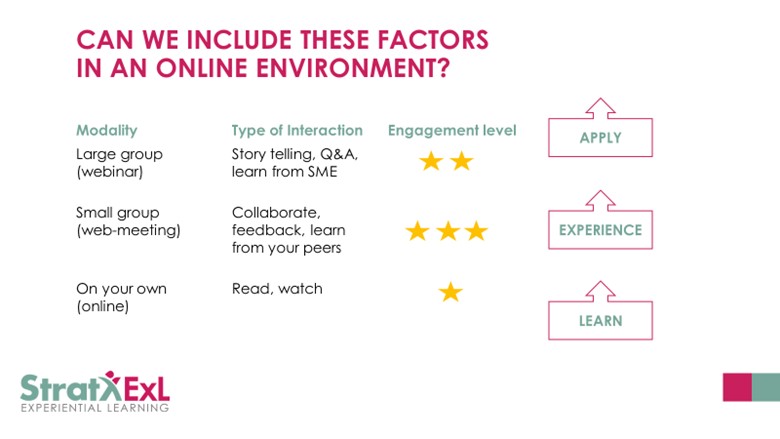When designing an experiential learning initiative, whether online or in person, what are the factors that drive engagement? Let us take you through our top success factors for creating engaging learning experiences and how you can apply them to the online environment.
But first, why not reflect on a couple of recent training program that were successful and ask yourself what were the factors that made them effective and engaging? Perhaps, you can find some similarities.
We have been running experiential learning programs for over 35 years and time and time again, the following 5 factors come up:
Factors That Drive Learning Engagement

Our top 5 success factors shown above help to drive learning engagement, but they can also be complimented by a number of other factors, such as:
- Practice / Application
- Personal / Coaching
- Sharing / Networking
- Fun / Memorable
- Reflection / Ongoing / Follow-through
- Challenging / Competitive
- Support / Leadership
- Authentic
Creating Engaging Online Learning Environments
It’s no secret online environments can pose some greater challenges than that of traditional face-to-face learning, but in today’s environment we must adapt. So, how can the factors shown above be applied to the online format to ensure it’s an engaging experienced?

Traditionally, online learning may have been used first for mandatory training, such as compliance. In that case, participants would typically do it on their own and read some information or watch some videos. The level of engagement would possibly be quite limited.
With a small group of people, going up the ladder on the image above, it’s easier to increase the level of engagement. Group work and allowing participants to interact and discuss with each other can be very powerful. Online, this can be done through breakout rooms, where a sub-group of the bigger group can meet (4 or 5 people vs. 20-25 people). Examples of interactive content can be a discussion of results of an assessment that can be done prior to the program, role play with actors, project work or an opportunity for pitching to each other (it helps develop presentations skills and business acumen skills).
Finally, with a large group of people (more than 25-30 people), in an online environment, this would typically be a webinar where interactions could be limited because of the number of people. This is where storytelling and being able to interact with a subject matter expert or with executives sharing their perspectives or their leadership stories could be powerful and engaging.
How to address the needs of senior level audiences with online learning
Typically, online learning used to be geared towards junior level audiences. But we have found that some of our clients ask about using online experiences for senior level audiences.
We know that senior level audiences have unique needs, such as:
- Pressure on their time
- Need for collaboration is even greater as you move up
- Content needs to be truly engaging and challenging
Based on all these criteria, remote experiential learning initiatives can be very successful if designed properly. It is easier to have an executive attend or be part of a program online, where they don’t have to travel, than on-site. Also, it is a well-known phenomenon, as you move up the ladder that you can feel more isolated. Team reports to you but it is hard to connect to people at the same level – learning experiences can help with this, especially if they are cross functional or cross-business unit.
Transitioning From Face-to-Face to Remote Learning Programs: A Case Study
We’ve helped deliver the Capstone Class with our long-term partner, Saint Joseph’s University, for the past 20 years. The program, which is traditionally delivered in a face-to-face environment, puts to practice all the learnings that participants have taken over the course of their studies for the class of executive MBAs. Hear directly from Saint Joseph’s University as John Dart takes you through the success and a few surprises of delivering the program 100% remote for the first-time.
We hope this blog has inspired you to turn your online learning programs into engaging experiences. To support you on this journey, we'd like to share our Experiential Learning User's Guide with you today.









